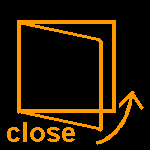Hensoldt Geodätisches Fernrohr (32 x 32)
| 1902 nutzte Hensoldt sein Penta-Prisma auch für ein "Geodätisches Fernrohr" (s. u. Skizze; Porezag, 2001, S. 337). Das gezeigte Exemplar ist auf einem justierbaren Stativ und hat einen schwarz lackierten Haupttubus. Nach der Skizze ist das das Pentaprisma in einem runden Gehäuse untergebracht, jedoch befindet sich beim Öffnen des vorliegenden Exemplars dort ein Porro 2 Prisma (s. Foto). So könnte es auch evtl. ein Nachfolgemodell oder das tatsächlich umgesetze Serienmodell sein. Auch weil das Instrument unbeschriftet ist (nur eine Zahl ist im Inneren des rudnen Gehäuses eingeritzt), lässt sich nicht ganz genau bestimmen, ob dies tatsächlich das Hensoldt-Modell ist. | In 1902 Hensoldt also used its penta prism for its geodetic telescope (see drawing below; Porezag, 2001, p. 337). The specimen depicted is mounted on a tripod with adjustments. The main tube is lacquered black. According to the drawing, the penta prism is built into a round housing. There are no markings apart from a number manually scratched in inside of the round housing. Hence, we cannot definiotely say whether this is really the Hensoldt model. The design differs from the drawing in some minor features, and when opening the housing this specimen has a Porro II prism system in it (cf. photo). Thus, this may also be a successor or the real model finally made by Hensoldt. |

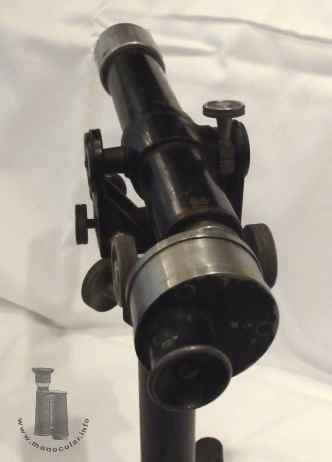
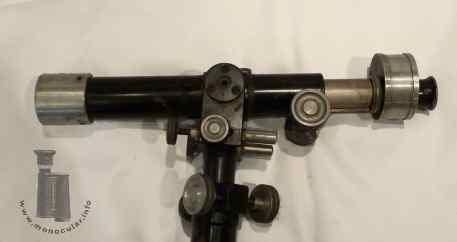
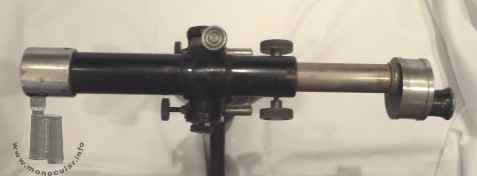
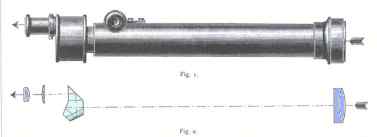
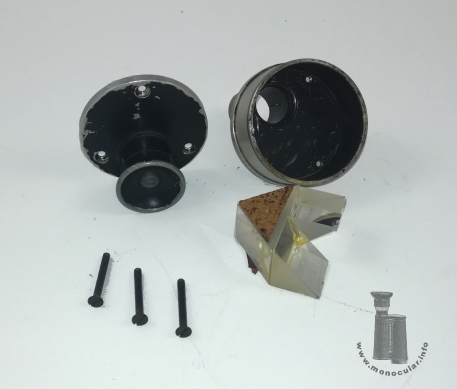
| Das Fernrohr hat eine 32 mm Objektivlinse und eine 1 mm Austrittspupille, so dass sich eine Vergrößerung von 32fach errechnen lässt. Es ist mit einer Zahntriebfokussierung ausgestattet und ist so 29 - 37cm lang. Das Okularstück ohne Dioptrieneinstellung hat eine schwarz lackierte Alu-Augenmuschel. Die 27 mm lange Prismendose mit einem Durchmesser von 55 mm hat einen dreifach verschraubten Deckel und ist ebenfalls wie auch die 4 cm lange Objektivfassung mit einem 43 mm Durchmesser aus Aluminium. Die Prismendose lässt sich am Fokusseriungsrohr rotieren. Der schwarz lackierte 188 mm lange Hauptubus ist 36 mm im Durchmesser und mit einer Zapfenmontierung auf das die Gabelhalterung des Dreifuß-Tischstativ gesetzt. Die Halterung hat Feintriebe für die vertikale und horizontale Ausrichtung. Beide können mit einem weiteren Aluminium-Rädchen arretiert werden. Mit einem Gewindetrieb kann das Stativrohr in der Höhe verstellt werden. So ist es möglich das Fernrohr von 35 cm bis zu 52 cm einzurichten. Das Gesamtgewicht liegt bei 4012 g. | The telescope has a 32 mm objective lens and a 1 mm exit pupil. Thus, its magnification can be calculated to be 32x. It has a rack and pinion focusing. The telescope's length varies between 29-37cm. The eyepiece has no dioptre adjustment and comes with a black painted aluminium eyecup. The 27 mm long prism box measures 55 mm in diameter and has a cover plate with three screws. The objective tube is 4 cm long and measures 43 mm in diameter. Both are made of aluminium. The prism box can be rotated on the focusing tube. The black lacquered 188 mm long main tube is 36 mm in diameter and mounted with trunnions on the fork-mount of the table tripod. The mount has fine adjustments for vertical and horizontal alignments. Both can be fastened with other aluminium knobs. The tripod rod is moved in height from 35 cm to 52 cm by a rack and pinion adjustement. The total weight is 4012 g. |
Fotos: Zeun

